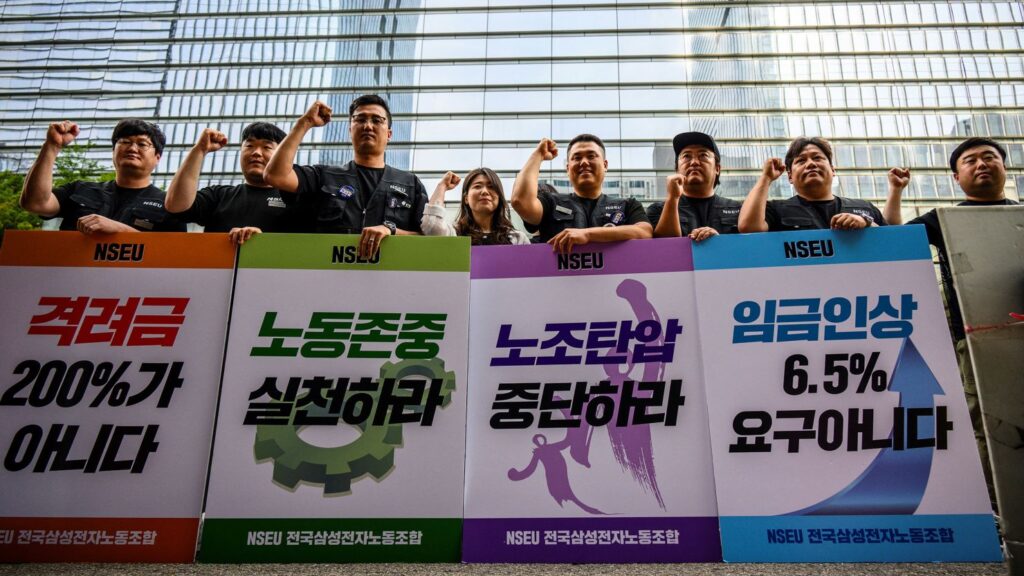
Samsung Chip Workers Edging Toward Complete Strike
Samsung’s Historic Strike Demands Fair Pay, Transparent Bonuses, and Improved Working Conditions – More Disruptions Expected
On June 7th, Samsung employees in South Korea embarked on their inaugural strike, orchestrated by the Nationwide Samsung Electronics Union (NSEU). This historic event involved around 28,000 union members, representing approximately a fifth of Samsung’s South Korean workforce.
The strike specifically targeted Samsung’s chip division, responsible for producing essential components such as RAM, NAND flash chips, USB sticks, SD cards, Exynos processors, camera sensors, modems, NFC chips, and power/display controllers. This action brought to the forefront longstanding issues concerning unionization within Samsung, signifying a significant shift in the company’s labor dynamics.
Throughout the strike, union members prominently displayed notices on Samsung facility doors, outlining their grievances and demands. Lee Hyun-kuk, vice president of the National Samsung Electronics Union, characterized the strike as “largely symbolic, but a pivotal start.” He stressed that the union has contingency plans for further strikes if management fails to address their concerns. Lee also underscored the union’s resolve by indicating that an all-encompassing general strike remains a possibility.
Central to their demands is a 6.5% salary increase, in contrast to Samsung’s proposed 5.1% raise, along with an additional day of annual leave and a more transparent method for calculating bonuses. Bonuses are particularly crucial as they constitute a significant portion of employees’ compensation.

In 2023, the bonus calculation formula, which considers both operating profit and cost of capital, resulted in no bonuses being disbursed to workers. The union argues that bonuses should solely reflect operating profit. Samsung’s chip division reported a profit of US$1.4 billion in the first quarter of this year.
Samsung Group has consistently opposed unionization efforts, implementing policies that maintain low wages, offer minimal benefits, and enforce extended work hours.
In December 2013, the Korean Metal Workers’ Union (KMWU), supported by the IndustriALL Global Union, disclosed widespread violations of workers’ rights within Samsung. These included allegations of kidnapping and physical violence against union leaders, alongside targeted management training programs designed to prevent union formation.
Samsung’s global reputation in the IT sector is marred by challenging working conditions marked by long hours and reliance on precarious employment arrangements. The company actively discourages union membership and pressures unionized precarious workers to disassociate from their representative organizations. These tactics involve paying lower wages to union members and subjecting them to intensive monitoring, raising significant ethical concerns about Samsung’s treatment of its technology industry workforce.
Samsung Electronics Co., Ltd operates with a hierarchical workforce structure that exhibits notable disparities. Highly compensated professionals and research and development personnel critical for innovation and product development occupy the top tier. Skilled tradespeople and manufacturing workers across Samsung’s global factories, including those in South Korea, form the middle tier, contributing to production under demanding conditions.

At the bottom of Samsung’s labor hierarchy are workers employed by contractors and subcontractors, a group for whom Samsung denies responsibility despite their essential role in the company’s operations.
The intense work culture at Samsung came to light during the 2012 Samsung-Apple patent trial, which exposed rigorous conditions among research and development staff. Chief designer Wang Jee-yuen’s testimony vividly illustrated the demanding nature of the job, including prolonged work hours that adversely affected personal well-being and family life.
Women form a substantial segment of Samsung’s skilled labor force, often recruited from small towns to work in semiconductor labs. They endure prolonged shifts, rotating schedules, and exposure to hazardous substances.
Samsung is not unique in its exploitation of workers. Research reveals that iPhone assembly line workers today endure exploitation levels 25 times higher than textile workers in 19th-century England, reaching an astonishing 2,458%. This means workers spend the majority of their day enriching the company, with only a fraction of their labor contributing to their wages.
Amazon, a major US employer, is notorious for its harsh working conditions. Warehouse employees face physical strain, workplace injuries, and mental health challenges as routine hazards. The company employs sophisticated surveillance systems to closely monitor worker activities, justified as measures to enhance safety. However, these systems often pressure workers to maintain an unsustainable pace to meet productivity targets.

Furthermore, Amazon has actively opposed unionization efforts within its workforce. In 2021, the company spent $4.2 million on consultants to dissuade workers from joining unions. Despite these challenges, workers achieved a significant milestone on April 1, 2022, with the establishment of the Amazon Labor Union (ALU), marking the first union at a US Amazon facility. This achievement followed a year-long struggle against Amazon’s aggressive anti-union tactics, gaining support from committed workers and organizers at the Staten Island warehouse.
In another instance of labor rights challenges, workers at the Maruti-Suzuki Manesar IMT plant in India faced management pressure when attempting to form the Maruti Suzuki Employees Union (MSEU) in Chandigarh in 2011. Management allegedly coerced workers to sign pledges against joining the MSEU upon discovering the unionization efforts.
In response, on June 4, 2011, 3,000 workers initiated a sit-in strike at the Manesar Plant to demand recognition of the Maruti Suzuki Employees Union (MSEU). In a retaliatory move, management fired 11 employees, including MSEU office bearers, on June 6, 2011, alleging they had incited the strike.
Over time, Maruti Suzuki has adjusted its workforce strategy by increasing the number of contract workers under precarious conditions while maintaining a smaller core of permanent employees.
These labor movements exemplify the ongoing global struggle of workers against exploitation by powerful corporations. They highlight the challenges and unjust treatment faced by workers, emphasizing the urgent need for systemic reforms to ensure fair treatment and equitable distribution of the benefits derived from their labor.










Leave a Reply